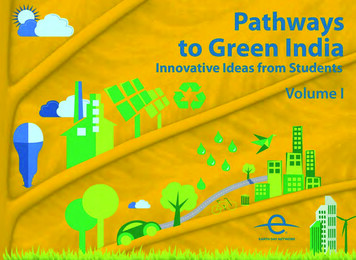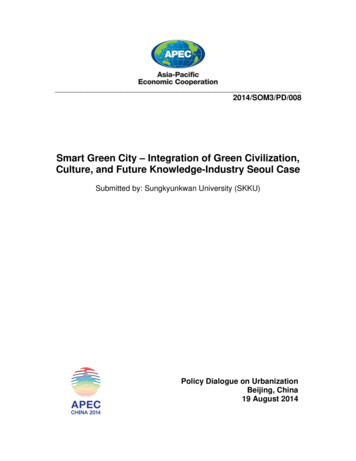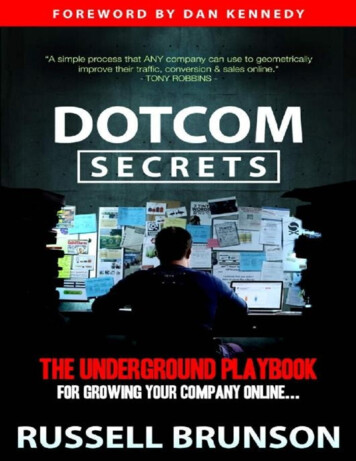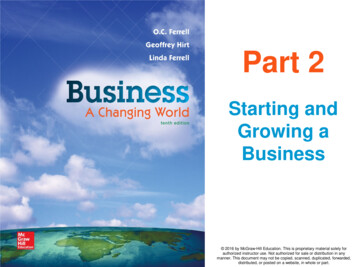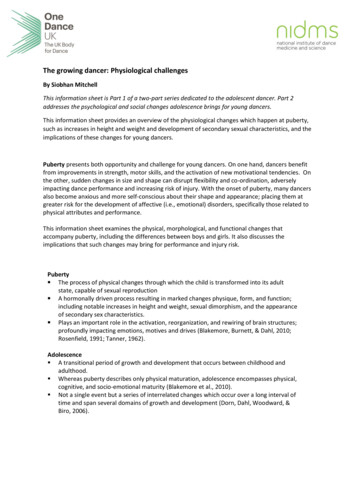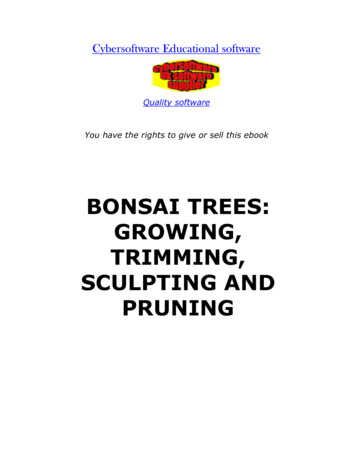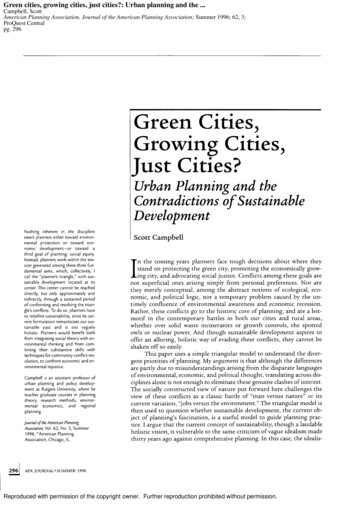
Transcription
Green cities, growing cities, just cities?: Urban planning and the .Campbell, ScottAmerican Planning Association. Journal of the American Planning Association; Summer 1996; 62, 3;ProQuest Centralpg. 296Green Cities,Growing Cities,Just Cities?Urban Planning and theContradictions of SustainableDevelopmentNothing inherent in the disciplinesteers planners either toward environmental protection or toward economic development-or toward athird goal of planning: social equity.Instead, planners work within the tension generated among these three fundamental aims, which, collectively, Icall the "planner's triangle," with sustainable development located at itscenter. This center cannot be reacheddirectly, but only approximately andindirectly, through a sustained periodof confronting and resolving the triangle's conflicts. To do so, planners haveto redefine sustainability, since its current formulation romanticizes our sustainable past and is too vaguelyholistic. Planners would benefit bothfrom integrating social theory with environmental thinking and from combining their substantive skills withtechniques for community conflict resolution, to confront economic and environmental injustice.Campbell IS an assistant professor ofurban planning and policy development at Rutgers University, where heteaches graduate courses in planningtheory, research methods, environmental economics, and regionalplanning.journal of the American PlanningAssociation, Vol. 62, No.3, Summer1996. American PlanningAssociation, Chicago, IL.2961Scott Campbelln the coming years planners face tough decisions about where theystand on protecting the green city, promoting the economically growing city, and advocating social justice. Conflicts among these goals arenot superficial ones arising simply from personal preferences. Nor arethey merely conceptual, among the abstract notions of ecological, economic, and political logic, nor a temporary problem caused by the untimely confluence of environmental awareness and economic recession.Rather, these conflicts go to the historic core of planning, and are a leitmotif in the contemporary battles in both our cities and rural areas,whether over solid waste incinerators or growth controls, the spottedowls or nuclear power. And though sustainable development aspires tooffer an alluring, holistic way of evading these conflicts, they cannot beshaken off so easily.This paper uses a simple triangular model to understand the divergent priorities of planning. My argument is that although the differencesare partly due to misunderstandings arising from the disparate languagesof environmental, economic, and political thought, translating across disciplines alone is not enough to eliminate these genuine clashes of interest.The socially constructed view of nature put forward here challenges theview of these conflicts as a classic battle of "man versus nature" or itscurrent variation, "jobs versus the environment." The triangular model isthen used to question whether sustainable development, the current object of planning's fascination, is a useful model to guide planning practice. I argue that the current concept of sustainability, though a laudableholistic vision, is vulnerable to the same criticism of vague idealism madethirty years ago against comprehensive planning. In this case, the idealis-IAPA JOURNAL SUMMER 1996Reproduced with permission of the copyright owner. Further reproduction prohibited without permission.
GREEN CITIES, GROWING CITIES, JUST CITIES?tic fascination often builds upon a romanticized viewof pre-industrial, indigenous, sustainable cultures inspiring visions, but also of limited modern applicability. Nevertheless, sustainability, if redefined andincorporated into a broader understanding of politicalconflicts in industrial society, can become a powerfuland useful organizing principle for planning. In fact,the idea will be particularly effective if, instead ofmerely evoking a misty-eyed vision of a peaceful ecotopia, it acts as a lightening rod to focus conflictingeconomic, environmental, and social interests. Themore it stirs up conflict and sharpens the debate, themore effective the idea of sustainability will be in thelong run.The paper concludes by considering the implications of this viewpoint for planning. The triangleshows not only the conflicts, but also the potentialcomplementarity of interests. The former are unavoidable and require planners to act as mediators, but thelatter area is where planners can be especially creativein building coalitions between once-separated interestgroups, such as labor and environmentalists, or community groups and business. To this end, plannersneed to combine both their procedural and their substantive skills and thus become central players in thebattle over growth, the environment, and socialjustice.The Planner's Triangle: ThreePriorities, Three ConflictsThe current environmental enthusiasm amongplanners and planning schools might suggest their innate predisposition to protect the natural environment. Unfortunately, the opposite is more likely to betrue: our historic tendency has been to promote thedevelopment of cities at the cost of natural destruction: to build cities we have cleared forests, fouled rivers and the air, leveled mountains. That is not thecomplete picture, since planners also have often cometo the defense of nature, through the work of conservationists, park planners, open space preservationists,the Regional Planning Association of America, greenbelt planners, and modern environmental planners.Yet along the economic-ecological spectrum, withRobert Moses, and Dave Foreman (of Earth First!)standing at either pole, the planner has no naturalhome, but can slide from one end of the spectrum tothe other; moreover, the midpoint has no specialclaims to legitimacy or fairness.Similarly, though planners often see themselves asthe defenders of the poor and of socio-economicequality, their actions over the profession's historyhave often belied that self-image (Harvey 1985). Plan-ners' efforts with downtown redevelopment, freewayplanning, public-private partnerships, enterprisezones, smokestack-chasing and other economic development strategies don't easily add up to equity planning. At best, the planner has taken an ambivalentstance between the goals of economic growth and economic justice.In short, the planner must reconcile not two, butat least three conflicting interests: to "grow" the economy, distribute this growth fairly, and in the processnot degrade the ecosystem. To classify contemporarybattles over environmental racism, pollutionproducing jobs, growth control, etc., as simply clashesbetween economic growth and environmental protection misses the third issue, of social justice. The "jobsversus environment" dichotomy (e.g., the spotted owlversus Pacific Northwest timber jobs) crudely collapsesunder the "economy" banner the often differing interests of workers, corporations, community members,and the national public. The intent of this paper's titleis to focus planning not only for "green cities andgrowing cities," but also for "just cities."In an ideal world, planners would strive to achievea balance of all three goals. In practice, however, professional and fiscal constraints drastically limit the leeway of most planners. Serving the broader publicinterest by holistically harmonizing growth, preservation, and equality remains the ideal; the reality ofpractice restricts planners to serving the narrower interests of their clients, that is, authorities and bureaucracies (Marcuse 1976), despite efforts to work outsidethose limitations (Hoffman 1989). In the end, planners usually represent one particular goal planningperhaps for increased property tax revenues, or moreopen space preservation, or better housing for thepoor while neglecting the other two. Where eachplanner stands in the triangle depicted in figure 1 defines such professional bias. One may see illustratedin the figure the gap between the call for integrative,sustainable development planning (the center of thetriangle) and the current fragmentation of professional practice (the edges). This point is developedlater.The Points (Corners) of the Triangle: theEconomy, the Environment, and EquityThe three types of priorities lead to three perspectives on the city: The economic development plannersees the city as a location where production, consumption, distribution, and innovation take place. The cityis in competition with other cities for markets and fornew industries. Space is the economic space of highways, market areas, and commuter zones.APA JOURNAL SUMMER 1996Reproduced with permission of the copyright owner. Further reproduction prohibited without permission.1297
SCOTT CAMPBELLthe property /conflict,"green,thedevelopmentconflictprofitable and fair"'(sustainable deuelopment?)'---··. -- EnvironmentalProtectionthe resourceconflictFIGURE 1. The triangle of conflicting goals for planning, and the three associated conflicts. Planners define themselves, implicidy, by where they stand on the triangle. The elusive ideal of sustainable development leads one to the center.The environmental planner sees the city as a consumer of resources and a producer of wastes. The cityis in competition with nature for scarce resources andland, and always poses a threat to nature. Space is theecological space of greenways, river basins, and ecological niches.The equity planner sees the city as a location ofconflict over the distribution of resources, of services,and of opportunities. The competition is within thecity itself, among different social groups. Space is thesocial space of communities, neighborhood organizations, labor unions: the space of access and segregation.Certainly there are other important views of thecity, including the architectural, the psychological,and the circulatory (transportation); and one couldconceivably construct a planner's rectangle, pentagon, or more complex polygon. The triangular shapeitself is not propounded here as the underlying geometric structure of the planner's world. Rather, it isuseful for its conceptual simplicity. More importantly, it emphasizes the point that a one-dimensional"man versus environment" spectrum misses the social conflicts in contemporary environmental disputes, such as loggers versus the Sierra Club, farmersversus suburban developers, or fishermen versusbarge operators (Reisner 1987; Jacobs 1989; McPhee1989; Tuason 1993).t2981Triangle Axis 1: The Property ConflictThe three points on the triangle represent divergent interests, and therefore lead to three fundamental conflicts. The first conflict-between economicgrowth and equity-arises from competing claims onand uses of property, such as between managementand labor, landlords and tenants, or gentrifying professionals and long-time residents. This growth-equityconflict is further complicated because each side notonly resists the other, but also needs the other for itsown survival. The contradictory tendency for a capitalist, democratic society to define property (such ashousing or land) as a private commodity, but at thesame time to rely on government intervention (e.g.,zoning, or public housing for the working class) to ensure the beneficial social aspects of the same property,is what Richard Foglesong (1986) calls the "propertycontradiction." This tension is generated as the privatesector simultaneously resists and needs social intervention, given the intrinsically contradictory nature ofproperty. Indeed, the essence of property in our society is the tense pulling between these two forces. Theconflict defines the boundary between private interestand the public good.Triangle Axis 2: The Resource ConflictJust as the private sector both resists regulation ofproperty, yet needs it to keep the economy flowing, soAPA JOURNAL SUMMER 1996Reproduced with permission of the copyright owner. Further reproduction prohibited without permission.
GREEN CITIES, GROWING CITIES, JUST CITIES?too is society in conflict about its priorities for naturalresources. Business resists the regulation of its exploitation of nature, but at the same time needs regulationto conserve those resources for present and future demands. This can be called the "resource conflict." Theconceptual essence of natural resources is thereforethe tension between their economic utility in industrial society and their ecological utility in the naturalenvironment. This conflict defines the boundary between the developed city and the undeveloped wilderness, which is symbolized by the "city limits." Theboundary is not fixed; it is a dynamic and contestedboundary between mutually dependent forces.Is there a single, universal economic-ecologicalconflict underlying all such disputes faced by planners? I searched for this essential, Platonic notion, butthe diversity of examples-water politics in California,timber versus the spotted owl in the Pacific Northwest, tropical deforestation in Brazil, park planning inthe Adirondacks, greenbelt planning in Britain, toname a few-suggests otherwise. Perhaps there is anUr-Konflikt) rooted in the fundamental struggle between human civilization and the threatening wilderness around us, and expressed variously over thecenturies. However, the decision must be left to anthropologists as to whether the essence of the spottedowl controversy can be traced back to Neolithic times.A meta-theory tying all these multifarious conflicts toan essential battle of "human versus nature" (and,once tools and weapons were developed and naturewas controlled, "human versus human")-that invitesskepticism. In this discussion, the triangle is used simply as a template to recognize and organize the common themes; to examine actual conflicts, individualcase studies are used. 2The economic-ecological conflict has several instructive parallels with the growth-equity conflict. Inthe property conflict, industrialists must curb theirprofit-increasing tendency to reduce wages, in order toprovide labor with enough wages to feed, house, andotherwise "reproduce" itself-that is, the subsistencewage. In the resource conflict, the industrialists mustcurb their profit-increasing tendency to increase timber yields, so as to ensure that enough of the forestremains to "reproduce" itself (Clawson 1975; Beltzerand Kroll1986; Lee, Field, and Burch 1990). This practice is called "sustained yield," though timber companies and environmentalists disagree about how far theforest can be exploited and still be "sustainable." (Ofcourse, other factors also affect wages, such as supplyand demand, skill level, and discrimination, just aslumber demand, labor prices, transportation costs,tariffs, and other factors affect how much timber isharvested.) In both cases, industry must leave enoughof the exploited resource, be it human labor or nature,so that the resource will continue to deliver in the future. In both cases, how much is "enough" is also contested.Triangle Axis 3: The Development ConflictThe third axis on the triangle is the most elusive:the "development conflict," lying between the poles ofsocial equity and environmental preservation. If theproperty conflict is characterized by the economysambivalent interest in providing at least a subsistenceexistence for working people, and the resource conflictby the economy's ambivalent interest in providing sustainable conditions for the natural environment, thedevelopment conflict stems from the difficulty of doing both at once. Environment-equity disputes arecoming to the fore to join the older dispute about economic growth versus equity (Paehlke 1994, 349-50).This may be the most challenging conundrum of sustainable development: how to increase social equityand protect the environment simultaneously, whetherin a steady-state economy (Daly 1991) or not. Howcould those at the bottom of society find greater economic opportunity if environmental protection mandates diminished economic growth? On a global scale,efforts to protect the environment might lead toslowed economic growth in many countries, exacerbating the inequalities between rich and poor nations. Ineffect, the developed nations would be asking thepoorer nations to forgo rapid development to save theworld from the greenhouse effect and other globalemergencies.This development conflict also happens at the local level, as in resource-dependent communities,which commonly find themselves at the bottom of theeconomy's hierarchy of labor. Miners, lumberjacks,and mill workers see a grim link between environmental preservation and poverty, and commonly mistrustenvironmentalists as elitists. Poor urban communitiesare often forced to make the no-win choice betweeneconomic survival and environmental quality, as whenthe only economic opportunities are offered by incinerators, toxic waste sites, landfills, and other noxiousland uses that most neighborhoods can afford to oppose and do without (Bryant and Mohai 1992; Bullard1990, 1993). If, as some argue, environmental protection is a luxury of the wealthy, then environmentalracism lies at the heart of the development conflict.Economic segregation leads to environmental segregation: the former occurs in the transformation of natural resources into consumer products; the latter occursas the spoils of production are returned to nature. Inequitable development takes place at all stages of thematerials cycle.APA JOURNAL SUMMER 1996Reproduced with permission of the copyright owner. Further reproduction prohibited without permission.1299
SCOTT CAMPBELLConsider this conflict from the vantage of equityplanning. Norman Krumholz, as the planning directorin Cleveland, faced the choice of either building regional rail lines or improving local bus lines (Krumholz et al. 1982). Regional rail lines would encouragethe suburban middle class to switch from cars to masstransit; better local bus service would help the innercity poor by reducing their travel and waiting time.One implication of this choice was the tension between reducing pollution and making transportationaccess more equitable, an example of how bias towardsocial inequity may be embedded in seemingly objective transit proposals.Implications of the Planner'sTriangle ModelConflict and Complementarity in the TriangleThough I use the image of the triangle to emphasize the strong conflicts among economic growth, environmental protection, and social justice, no pointcan exist alone. The nature of the three axial conflictsis mutual dependence based not only on opposition,but also on collaboration.Consider the argument that the best way to distribute wealth more fairly (i.e., to resolve the propertyconflict) is to increase the size of the economy, so thatsociety will have more to redistribute. Similarly, wecan argue that the best way to improve environmentalquality (i.e., to resolve the resource conflict) is to expand the economy, thereby having more money withwhich to buy environmental protection. The former istrickle-down economics; can we call the latter "trickledown environmentalism"? One sees this logic in theconclusion of the Brundtland Report: "If large partsof the developing world are to avert economic, social,and environmental catastrophes, it is essential thatglobal economic growth be revitalized" (World Commission on Environment and Development 1987).However, only if such economic growth is more fairlydistributed will the poor be able to restore and protecttheir environment, whose devastation so immediatelydegrades their quality of life. In other words, the development conflict can be resolved only if the propertyconflict is resolved as well. Therefore, the challenge forplanners is to deal with the conflicts between competing interests by discovering and implementing complementary uses.The Triangle's Origins in a Social View of NatureOne of the more fruitful aspects of recent interdisciplinary thought may be its linking the traditionallyseparate intellectual traditions of critical social theoryand environmental science/policy (e.g., Smith 1990;300IWilson 1992; Ross 1994). This is also the purpose ofthe triangle figure presented here: to integrate the environmentalist's and social theorist's world views. Onone side, an essentialist view of environmental conflicts ("man versus nature") emphasizes the resourceconflict. On another side, a historical materialist viewof social conflicts (e.g., capital versus labor) emphasizes the property conflict. By simultaneously considering both perspectives, one can see more clearly thesocial dimension of environmental conflicts, that is,the development conflict. Such a synthesis is not easy:it requires accepting the social construction of naturebut avoiding the materialistic pitfall of arrogantly de·nying any aspects of nature beyond the labor theoryof value.Environmental conflict should not, therefore, beseen as simply one group representing the interests ofnature and another group attacking nature (though it:often appears that way).' Who is to say that the lum··berjack, who spends all his or her days among trees(and whose livelihood depends on those trees), is anyless close to nature than the environmentalist takinga weekend walk through the woods? Is the lumberjackable to cut down trees only because s/he is "alienated"from the "true" spirit of nature-the spirit that thehiker enjoys? In the absence of a forest mythology, nei·ther the tree cutter nor the tree hugger-nor the thirdparty, the owner/lessee of the forest-can claim an innate kinship to a tree. This is not to be an apologistfor clear-cutting, but rather to say that the merits ofcutting versus preserving trees cannot be decided ac·cording to which persons or groups have the "truest"relationship to nature.The crucial point is that all three groups have aninteractive relationship with nature: the differences liein their conflicting conceptions of nature, their conflicting uses of nature, and how they incorporate nature into their systems of values (be they community,economic, or spiritual values). This clash of humanvalues reveals how much the ostensibly separate domains of community development and environmentalprotection overlap, and suggests that planners shoulddo better in combining social and environmental models. One sees this clash of values in many environmental battles: between the interests of urban residentsand those of subsidized irrigation farmers in California water politics; between beach homeowners andcoastal managers trying to control erosion; betweenrich and poor neighborhoods, in the siting of incinerators; between farmers and environmentalists, in restrictions by open space zoning. Even then-PresidentGeorge Bush weighed into such disputes during his1992 campaign when he commented to a group ofloggers that finally people should be valued more thanAPA JOURNAL. SUMMER 1996Reproduced with permission of the copyright owner. Further reproduction prohibited without permission.
GREEN CITIES, GROWING CITIES, JUST CITIES?spotted owls (his own take on the interspecies equityissue). Inequity and the imbalance of political powerare often 1ssues at the heart of economicenvironmental conflicts.Recognition that the terrain of nature is contestedneed not, however, cast us adrift on a sea of sociallyconstructed relativism where "nature" appears as anarbitrary idea of no substance (Bird 1987; Soja 1989).Rather, we are made to rethink the idea and to seethe appreciation of nature as an historically evolvedsensibility. I suspect that radical environmentalistswould criticize this perspective as anthropocentric environmentalism, and argue instead for an ecocentricworld view that puts the Earth first (Sessions 1992;Parton 1993). It is true that an anthropocentric view,if distorted, can lead to an arrogant optimism aboutcivilization's ability to reprogram nature throughtechnologies ranging from huge hydroelectric and nuclear plants down to genetic engineering. A rigid beliefin the anthropocentric labor theory of value, Marxistor otherwise, can produce a modern-day Narcissus asa social-constructionist who sees nature as merely reflecting the beauty of the human aesthetic and thevalue of human labor. In this light, a tree is devoid ofvalue until it either becomes part of a scenic area or istransformed into lumber. On the other hand, even asradical, ecocentric environmentalists claim to see "truenature" beyond the city limits, they are blind to howtheir own world view and their definition of natureitself are shaped by their socialization. The choice between an anthropocentric or an ecocentric world viewis a false one. We are all unavoidably anthropocentric;the question is which anthropomorphic values andpriorities we will apply to the natural and the socialworld around us.Sustainable Development: Reachingthe Elusive Center of the TriangleIf the three corners of the triangle represent keygoals in planning, and the three axes represent thethree resulting conflicts, then I will define the centerof the triangle as representing sustainable development: the balance of these three goals. Getting to thecenter, however, will not be so easy. It is one thing tolocate sustainability in the abstract, but quite anotherto reorganize society to get there.At first glance, the widespread advocacy of sustainable development is astonishing, given its revolutionary implications for daily life (World Commission1987; Daly and Cobb 1989; Rees 1989; World Bank1989; Goodland 1990; Barrett and Bohlen 1991; Korten 1991; Vander Ryn and Calthorpe 1991). It is getting hard to refrain from sustainable development;arguments against it are inevitably attached to thestrawman image of a greedy, myopic industrialist.Who would now dare to speak up in opposition? Twointerpretations of the bandwagon for sustainable development suggest themselves. The pessim1st1cthought is that sustainable development has beenstripped of its transformative power and reduced toits lowest common denominator. After all, if both theWorld Bank and radical ecologists now believe in sustainability, the concept can have no teeth: it is so malleable as to mean many things to many people withoutrequiring commitment to any specific policies. Actionsspeak louder than words, and though all endorse sustainability, few will actually practice it. Furthermore,any concept fully endorsed by all parties must surelybe bypassing the heart of the conflict. Set a goal farenough into the future, and even conflicting interestswill seem to converge along parallel lines. The conceptcertainly appears to violate the Karl Popper's requirement that propositions be falsifiable, for to reject sustainability is to embrace nonsustainability-and whodares to sketch that future? (Ironically, the nonsustainable scenario is the easiest to define: merely theextrapolation of our current way of life.)Yet there is also an optimistic interpretation of thebroad embrace given sustainability: the idea has become hegemonic, an accepted meta-narrative, a given.It has shifted from being a variable to being the parameter of the debate, almost certain to be integratedinto any future scenario of development. We shouldtherefore neither be surprised that no definition hasbeen agreed upon, nor fear that this reveals a fundamental flaw in the concept. In the battle of big publicideas, sustainability has won: the task of the comingyears is simply to work out the details, and to narrowthe gap between its theory and practice.Is Sustainable Development a Useful Concept?Some environmentalists argue that if sustainabledevelopment is necessary, it therefore must be possible. Perhaps so, but if you are stranded at the bottomof a deep well, a ladder may be impossible even thoughnecessary. The answer espoused may be as much anideological as a scientific choice, depending onwhether one's loyalty is to Malthus or Daly. The morepractical question is whether sustainability is a usefulconcept for planners. The answer here is mixed. Thegoal may be too far away and holistic to be operational: that is, it may not easily break down into concrete, short-term steps. We also might be able to definesustainability yet be unable ever to actually measure itor even know, one day in the future, that we hadachieved it. An old eastern proverb identifies the western confusion of believing that to name something isAPA JOURNAL SUMMER 1996Reproduced with permission of the copyright owner. Further reproduction prohibited without permission.1301
SCOTT CAMPBELLto know it. That may be the danger in automaticallyembracing sustainable development: a facile confidence that by adding the term "sustainable" to all ourexisting planning documents and tools (sustainablezoning, sustainable economic development, sustainable transportation planning), we are doing sustainableplanning. Conversely, one can do much beneficial environmental work without ever devoting explicit attention to the concept of sustainability.Yet sustainability can be a helpful concept in thatit posits the long-term planning goal of a socialenvironmental system in balance. It is a unifying concept, enormously appealing to the imagination, thatbrings together many different environmental concerns under one overarching value. It defines a set ofsocial priorities and articulates how society values theeconomy, the environment, and equity (Paehlke 1994,360). In theory, it allows us not only to calculatewhether we have attained sustainability, but also todetermine how far away we are. (Actual measurement,though, is another, harder task.) Clearly, it can be argued that, though initially flawed and vague, the concept can be transformed and refined to be of use toplanners.History, Equity, and Sustainable DevelopmentOne obstacle to an accurate, working definition ofsustainability may well be the historical perspectivethat sees the practice as pre-existing, either in our pastor as a Platonic concept. I believe instead that our sustainable future does not yet exist, either
own survival. The contradictory tendency for a capital ist, democratic society to define property (such as housing or land) as a private commodity, but at the same time to rely on government intervention (e.g., zoning, or public housing for the working class) to en
